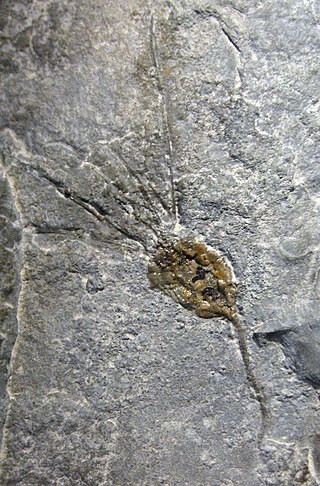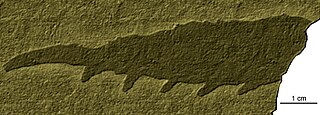
Felipe VI is King of Spain. In accordance with the Spanish Constitution, as monarch, he is head of state and commander-in-chief of the Spanish Armed Forces, holding the military rank of Captain General, and also plays the role of the supreme representation of Spain in international relations.

Acidobacteriota is a phylum of Gram-negative bacteria. Its members are physiologically diverse and ubiquitous, especially in soils, but are under-represented in culture.
The Gemmatimonadota are a phylum of bacteria established in 2003. The phylum contains two classes Gemmatimonadetes and Longimicrobia.

Gogia is a genus of primitive eocrinoid blastozoan from the early to middle Cambrian.

Acontheus is a genus of trilobites belonging to the Family Corynexochidae, Order Corynexochida, and is geographically widespread having been recorded from middle Cambrian strata in Sweden, Newfoundland, Germany, Siberia, Antarctica, Queensland, China and Wales.
Paleontology or palaeontology is the study of prehistoric life forms on Earth through the examination of plant and animal fossils. This includes the study of body fossils, tracks (ichnites), burrows, cast-off parts, fossilised feces (coprolites), palynomorphs and chemical residues. Because humans have encountered fossils for millennia, paleontology has a long history both before and after becoming formalized as a science. This article records significant discoveries and events related to paleontology that occurred or were published in the year 1985.

The Wheeler Shale is a Cambrian (c. 507 Ma) fossil locality world-famous for prolific agnostid and Elrathia kingii trilobite remains and represents a Konzentrat-Lagerstätte. Varied soft bodied organisms are locally preserved, a fauna and preservation style normally associated with the more famous Burgess Shale. As such, the Wheeler Shale also represents a Konservat-Lagerstätten.
Paleontology or palaeontology is the study of prehistoric life forms on Earth through the examination of plant and animal fossils. This includes the study of body fossils, tracks (ichnites), burrows, cast-off parts, fossilised feces (coprolites), palynomorphs and chemical residues. Because humans have encountered fossils for millennia, paleontology has a long history both before and after becoming formalized as a science. This article records significant discoveries and events related to paleontology that occurred or were published in the year 2010.

Perkinsids are single-celled protists that live as intracellular parasites of a variety of other organisms. They are classified as the class Perkinsea within the monotypic phylum Perkinsozoa. It is part of the eukaryotic supergroup Alveolata, along with dinoflagellates, their closest relatives, and another parasitic group known as Apicomplexa. Perkinsids are found in aquatic environments, as parasites of dinoflagellates and various animals.

Mureropodia is an animal that existed in what is now the Valdemiedes Formation of Spain during the early Cambrian period. It was described by José Antonio Gámez Vintaned, Eladio Liñán and Andrey Yu. Zhuravlev in 2011, and the type and only species is M. apae.

Paleontology or palaeontology is the study of prehistoric life forms on Earth through the examination of plant and animal fossils. This includes the study of body fossils, tracks (ichnites), burrows, cast-off parts, fossilised feces (coprolites), palynomorphs and chemical residues. Because humans have encountered fossils for millennia, paleontology has a long history both before and after becoming formalized as a science. This article records significant discoveries and events related to paleontology that occurred or were published in the year 2013.

The Luolishaniidae or Luolishaniida are a group of Cambrian and Ordovician lobopodians with anterior 5 or 6 pairs of setiferous lobopods. Most luolishaniids also have posterior lobopods each with a hooked claws, and thorn-shaped sclerites arranged as three or more per trunk segment. The type genus is based on Luolishania longicruris Hou and Chen, 1989, from the Chengjiang Lagerstatte, South China. They are presumed to have been benthic suspension or filter feeders.
Paleontology or palaeontology is the study of prehistoric life forms on Earth through the examination of plant and animal fossils. This includes the study of body fossils, tracks (ichnites), burrows, cast-off parts, fossilised feces (coprolites), palynomorphs and chemical residues. Because humans have encountered fossils for millennia, paleontology has a long history both before and after becoming formalized as a science. This article records significant discoveries and events related to paleontology that occurred or were published in the year 2015.

Pycnodontidae is an extinct family of ray-finned fishes, ranging from the Jurassic period until the Eocene. It was the largest and most derived family of the successful Mesozoic fish order Pycnodontiformes, and the only member of it to survive into the Cenozoic.

Helobata is a mostly Neotropical genus of water scavenger beetle in the family Hydrophilidae. It contains 13 described species, one of which is broadly distributed, reaching North America.
María Euridice Páramo Fonseca is a Colombian paleontologist and geologist. She has contributed to paleontology in Colombia in the fields of describing various Cretaceous reptiles, most notably the mosasaurs Eonatator and Yaguarasaurus, the ichthyosaur Kyhytysuka, and the plesiosaurs Leivanectes and Stenorhynchosaurus.
Teratopodus is an ichnogenus of titanosaurian sauropod footprint. It includes a single species, T. malarguensis, known from prints found in the Late Cretaceous Anacleto Formation of Argentina. The Teratopodus tracks represent some of the best sauropod pes tracks currently known from South America.

Fortunictis is a fossil genus of metailurin machairodontine (saber-toothed) felid containing only one species, Fortunictis acerensis. Both the genus and species were described by paleontologist Joan Pons-Moyà in 1987 based on material from Casa del Acero in Spain, which is dated back to the Upper Miocene.












